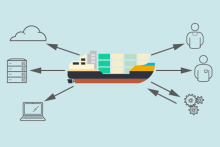How are IT leaders using hybrid cloud? What are the keys to hybrid cloud security? What is multi-cloud vs. hybrid cloud? Our comprehensive guide shares advice from CIOs and cloud experts

What is multi-cloud vs. hybrid cloud?
How do containers and microservices work with hybrid cloud?
How can I prepare for the hybrid cloud model?
What are the key hybrid cloud security considerations?
How does hybrid cloud help with digital transformation?
How can I manage multiple hybrid cloud vendors?
How can I find and retain hybrid cloud talent?
Where can I learn more about hybrid cloud?
IT leaders looking to learn and do more with the hybrid cloud computing model have many choices right now – just the pace of developments and new offers can seem overwhelming.
“I often refer to this year as the year of the cloud land grab,” says Ed Featherston, VP and principal architect at Cloud Technology Partners. “I liken it to the homestead years of the 1800s in the U.S., when the different territories tried attracting homesteaders for mutual benefit and growth.”
How are IT leaders using hybrid cloud? What is multi-cloud and how does it differ from hybrid cloud? What are the key hybrid cloud security considerations? Where can I find hybrid cloud talent? Amid all the noise, you have questions. We have rounded up answers.
Our hybrid cloud guide brings you the latest and best information from our ongoing hybrid cloud coverage, so you can get up to speed in one spot. Let’s delve into expert advice and analysis from cloud community experts – and top CIOs.
What is hybrid cloud?
Hybrid cloud is not a product, or a place: It’s an approach to cloud computing that includes a combination of private (on-premises or managed/hosted) and public cloud environments. A hybrid cloud environment lets you choose the right workload for the right environment, as well as move workloads around as business needs and technology change.
Consider this hybrid cloud definition from Radhesh Balakrishnan, general manager, OpenStack, Red Hat: “A mix of on-premises private cloud and third-party public cloud with orchestration between these two.” Your mix may include on-premises infrastructure, virtualization, bare-metal servers, and/or containers.
Increasingly, both containers and microservices are being used in concert with a hybrid cloud environment.
Why use hybrid cloud?
Ask IT leaders what appeals about the hybrid cloud model and you typically hear two top answers: Agility and speed.
“In a ‘fail fast’ world, waiting several weeks for infrastructure to be deployed in order to support a new idea – that may only be deployed for a few days – is a nonstarter, ” says Nathan A. Ulery, managing director, performance services at IT consulting firm West Monroe Partners.
Portable workloads running on cloud services help IT support business experiments that have to happen fast. They also help IT support business projects that get spun up first without IT being involved. Hybrid cloud’s flexibility helps IT and the business stay agile.

SunTrust CIO Anil Cheriyan recently wrote about his team’s formula for speed. His five-part approach includes cloud, modular architecture, DevOps, agile development, and design thinking. “Each plays a critical role in allowing us to better serve our clients and to move faster,” he writes.
But IT has shown it does not want to put all its eggs in one cloud provider’s basket. Hybrid also eases vendor lock-in concerns. As we recently reported, “One interesting data point in Kleiner Perkins Caufield & Byers venture capitalist Mary Meeker’s 2017 Internet Trends report is that while CIO security concerns regarding public cloud providers are trending down, concerns regarding vendor lock-in are trending up.”
“In 2012, 42 percent of respondents cited data security among their top three worries, but only 35 percent did in 2015. And while 7 percent cited vendor lock-in concerns in 2012, 22 percent did so in 2015.”
Consistent customer experience and resiliency matter too: Many IT leaders have decided that a multi-cloud strategy offers strong protection against downtime – and on the security front, often better security expertise than they have in-house.

Consider how Peter Weis, VP and CIO of shipping and logistics company Matson, recently described his cloud journey to us. “We didn't go to the cloud for cloud’s sake. We went to the cloud to fulfill a strategic business vision,” Weis says. “Matson has a premium brand, backed up by our number one rating in our industry three years running. Our overarching business strategy was to be able to expand globally into new markets without compromising our level of service. How do you stay the premier ocean carrier in the world, yet still expand?” Matson needed to ensure that any new market received the same high level of service, that the customer experience was consistent. “That can only be done, in my view, through the cloud,” Weis says.
What is multi-cloud vs. hybrid cloud?
When discussing hybrid cloud, you will also increasingly hear the term multi-cloud. What’s the difference? Think of hybrid cloud as a model and multi-cloud as a strategy – one that involves using a mix of multiple cloud providers.
You can have a hybrid cloud environment using only one cloud provider (Amazon, Google, Azure, etc.). But more CIOs are deciding to use multiple providers, for reasons of flexibility, ability to manage cost, and protection against provider outages. It also means you get to take advantages as the various providers introduce their own innovations.
“[A] multi-cloud strategy allows an organization to meet specific workload or application requirements – both technically and commercially – by consuming cloud services from several cloud providers,” Red Hat’s Balakrishnan says. “Not every department, team, business function, or application or workload will have similar requirements in terms of performance, privacy, security, or geographic reach for their cloud. Being able to use multiple cloud providers that meet their various application and data needs is critical as cloud computing has become more mature and mainstream.”
“Multi-cloud is more of a strategy,” says Kelly Begeny, channel manager at DSM Technology Consultants. A multi-cloud strategy makes sense for many hybrid cloud environments, but the two things are not the same.
How do containers and microservices work with hybrid cloud?

“Microservices – single-function services built by small teams, independent from other functions, and communicating only through public interfaces – simply make a great match for containers,” as Red Hat technology evangelist Gordon Haff recently noted. “Microservices plus containers represent a shift to delivering applications through modular services that can be reused and rewired to perform new tasks.”
“Containerizing services like messaging, mobile app development and support, and integration lets developers build applications, integrate with other systems, orchestrate using rules and processes, and then deploy across hybrid environments,” Haff says.
The end result: Faster and easier development, and less error-prone provisioning and configuration. “That adds up to more productive – and hopefully, less stressed – developers,” Haff notes. See our recent article, Microservices and containers: 6 things to know at start time.
How can I prepare for the hybrid cloud model?
Preparation can make or break your hybrid cloud effort. It starts with this question: What is the business goal that the hybrid model will help you pursue? CIOs must be able to articulate the answer clearly, to everyone from the CEO to IT team members. (For an example explanation, see how Peter Weis of Matson articulated his cloud mission, above, in Why use hybrid cloud? )
Then you can address the architecture and tools questions. Which applications make sense to move to the cloud model? How should the timing work? Your answers to those questions will be shaped by your business goals, current technology landscape, and culture, of course. For a detailed look at how to start analyzing your hybrid strategy and choosing the right homes for the right applications, see our related article, Hybrid cloud: 8 questions to ask first.
What are the key considerations for hybrid cloud security?
As we recently noted, “Hybrid cloud should strengthen your organization’s security posture, not diminish it. But that doesn’t mean improved security is a default setting. While security fears are declining as cloud matures, security remains an ongoing challenge that needs to be managed in any organization.”

Hybrid cloud security is a big topic; it can be hard to know where to focus. What are the hybrid cloud security questions that you should bear down on now? It starts with visibility. “Too often in modern IT, CIOs and other IT leaders have blind spots in their environments, or they focus too narrowly (or even exclusively) on their on-premises infrastructure,” cybersecurity veteran J. Wolfgang Goerlich, who serves as VP of strategic programs at CBI, told us.
Other key issues include asset ownership controls; compliance controls; security tool interactions; communications, and risk assessment. See our related article, Hybrid cloud security, 8 key considerations. As your hybrid cloud strategy grows, so should your security planning.
How does hybrid cloud help with digital transformation?
We know, you’re getting a little burned out on the word “transformation.” Nonetheless, many companies are charged with transformation right now, whether to an entire business model, an operating model, or a specific business function. To support this level of change, IT needs to enable innovation, not slow it down.
That meshes with how IT leaders often describe their cloud project goals: better business results and customer experiences. “Interestingly, at companies succeeding with digital transformation, the transformation and hybrid cloud work often intersect,” as we have noted.
“I believe hybrid cloud technologies are a requirement for organizations going through digital transformations,” says Nathan A. Ulery, managing director, performance services at IT consulting firm West Monroe Partners. “In many ways, IT leaders are seeing hybrid cloud technologies as a way of allowing them to transform from being the ‘department of no’ to the ‘department of yes’ – which is a critical component for digital efforts.”
For Jonathan Feldman, CIO of the city of Asheville, NC, cloud and digital transformation come together as his team opens up new ways for internal and external customers to access and analyze data – especially to quickly test hypotheses. “We’re enabling employees to use data instead of worshipping at the altar of IT. And the data is accessible to people inside and outside the organization.”

Collaborative applications and cloud storage will start an organization down this road, but the real magic and speed happen when you start tapping into APIs for that data, Feldman notes. “Now we can put together dashboards that are user-created,” he says – as opposed to the old days of holding weeks of meetings about what needed to be in a dashboard, then IT building it.
“A digital organization is extremely performance-metric based,” Feldman says. “We have to be able to collect data about whether hypotheses are true.”
For more on how hybrid and digital transformation work in concert, see our related article, How hybrid cloud fits with digital transformation.
How can I manage multiple hybrid cloud vendors wisely?
You may love the flexibility of hybrid cloud, but it also means juggling multiple vendors and service providers. One starting piece of advice: Implement a management strategy in phases.
“Start by managing each vendor individually – most companies start in this way – for a quick return on investment and to build up the expertise necessary for the next phases,” advises Alessandro Perilli, GM, management strategy, at Red Hat. “Then, gradually unify the governance of the multi-vendor environment by focusing, one by one, on the areas that are critical for your hybrid cloud management.”
Prioritize security, visibility for your management tools, and compatibility and portability for your workloads. Containers can really simplify matters on the portability front. For in-depth advice, see our related article, How to manage multiple hybrid cloud vendors: 8 tips.
How can I find and retain hybrid cloud talent?
If you’re struggling to find, attract, and retain IT pros who know how to manage hybrid cloud environments, you’re not alone.
“Finding an individual who has a strong grasp over both private and public cloud environments is tough,” says Patrick Circelli, regional recruiting manager at the IT staffing firm Mondo. What tactics can you use to get the job done?
Look for people who have worked at both large enterprises and startups or other smaller companies, Circelli advises. The larger organizations often grappled with private clouds, while the smaller ones may have had more flexibility to try things with public cloud services.

Ellucian CIO Lee Congdon recently wrote about how a cloud focus has changed his priorities for IT skill sets. “You’ve got to both plan for and have a vehicle for developing or acquiring the skills necessary to manage the very different environments and processes that comprise cloud computing,” Congdon writes. “With those skills will come a very different culture. Unlike some traditional environments, cloud is high speed. Cloud is process-oriented. Cloud is DevOps. Cloud is consistency.” Congdon prioritizes people with DevOps, security, communication, and financial skills.
What will help you attract and retain hybrid cloud pros? Learning opportunities, autonomy, competitive salary and the ability to work remotely may be crucial. Get detailed advice in our related article, Hybrid cloud talent: How to find it and keep it.
Where can I learn more about hybrid cloud?
Want even more wisdom on hybrid cloud and multi-cloud strategy? Explore these articles and papers:
4 hybrid cloud misconceptions, examined
Multi-cloud management: 6 expert tips
Multi-cloud strategy: 8 things to know
How to future-proof your IT career in the age of hybrid IT
SunTrust CIO's formula for speed relies on cloud, DevOps
Why the future of cloud is open (Red Hat whitepaper)
Imperative for hybrid IT: Cloud and innovation in the modern era (Analyst paper)
6 trends shaping IT cloud strategies today (CIO.com)
The five fundamentals of effective cloud management (CIO.com)
Hybrid cloud: The smart person’s guide (TechRepublic)


